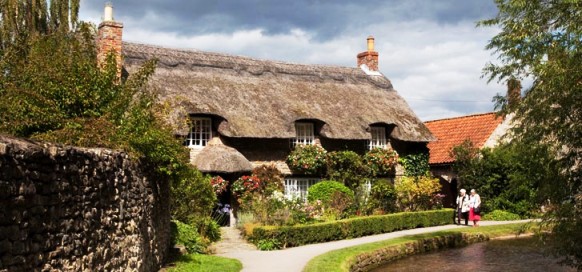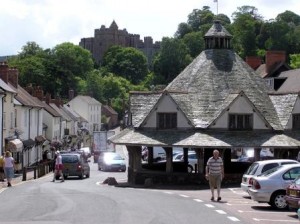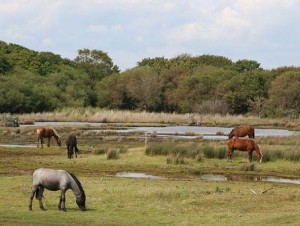
Thatch Cottage, Thornton-le-Dale, North York Moors National Park, North Yorkshire – by Mike Kipling © http://www.northyorkmoors.org.uk
The North York Moors National Park is located in the county of North Yorkshire in northern England. Designated a national park back in 1952, the North York Moors is one of the longest established national parks in the UK. The is known for its scenic coastline, stunning landscapes, moorland, ancient woodland and historic sites. The national park is managed by the North York Moors National Park Authority which includes a number of charming small towns and villages and provides a place of tranquillity and natural beauty in northern England. Located within the county of North Yorkshire, the largest ceremonial county in England, the national park along with the Yorkshire Dales account for approx 40% of the county.
The area has a long history and includes nearly 850 scheduled ancient monuments, plenty of charm and character and includes Sites of Special Scientific Interest (SSSIs) noted for both their biological and geological importance and National Nature Reserves at Forge Valley and Duncombe Park.
The area is popular for day trippers, horse riding, fishing, bird watching, golf, rock climbing, water sports, walking and cycling with a number of routes to explore. Visitors can enjoy the scenic landscape, coastline and varied wildlife, take part in a range of activities whilst benefiting from the tranquilly and peace of the area.
Quick Facts
North York Moors National Park:
Year of Designation: 1952
Population: 25,000
Scheduled Ancient Monuments: 846
Conservation Areas: 42
Size in square kilometres: 1,434
Main Settlements: Helmsley and Thornton-le-Dale.
Located in: North Yorkshire.
Highest Point: Urra Moor at 454 metres.
Attractions
North York Moors National Park is located in the north of England; the national park offers visitors the opportunity to enjoy the tranquillity and calm away from the hustle and bustle of large towns and cities, making it an ideal place to unwind and get closer to nature. Historically the North York Moors have been inhabited for many centuries, there have been archaeological finds dating back to the Mesolithic, Neolithic and the Bronze Age. Over the years the area has been used by the Romans and Anglo-Saxons; in the post medieval period farms, villages and hamlets were established, whilst in the 19th century the railways were established in the area. Currently the economy is based on agriculture and tourism. The park has more listed buildings, in excess of 3,000 than any other national park in the UK and the largest continuous expanse of heather moorland in England and includes the deepest mine in Europe at Boulby at 1,100 metres.
The location in the north of England within the county of North Yorkshire means Visitors to the North York Moors increase in the summer months with many visitors and holiday makers from the UK and beyond visiting the region on holiday and short breaks. The North York Moors are located within 3 hours drive from Liverpool, Manchester, Birmingham, Leeds and Sheffield, making it a particularly accessible location for visitors from the north and the midlands in England. From London and the south region, transport links means visitors can enjoy a weekend or short break at the national park.
The area is famous for its scenic areas of moorland, variety of landscapes that includes an impressive coastline, a variety of habitats that supporting a range of wildlife and a number of local towns and villages that are full of character, history and tradition. Like a number of national parks in the UK, the North York Moors does not include any major cities or towns within its borders, the main settlements include Helmsley and Thornton-le-Dale with a number of smaller villages and hamlets.
There are a number of towns that are located close by just outside the official border of the park, these include Guisborough, Kirkbymoorside, Stokesley, Northallerton and Whitby. The towns offer visitors convenient places from which to base themselves from when exploring the national park and the surrounding area with local facilities, amenities and accommodation. The city of York is located within 25 miles from the town of Helmsley at the southern edge of the national park. Middlesbrough is located 10 miles form the northern edge of the national park.
The Special qualities relating to the areas landscape, environment, history, wildlife, natural beauty and geology ensure North York Moors is a special place. The qualities include its areas of open moorland, distinctive dales, valleys, coastal cliffs, coastal headlands, ancient woodland and forests; that is rare to find in an area. The wealth of history, way of life, traditions and strong local communities in the local towns, villages and hamlets mark the area out as special. The archaeology, historical cultural heritage, nature conservation, diverse countryside that has inspired many a poet, artist and writer over the years makes the North York Moors a special place.
Local accommodation includes a choice of hotels including budget stays and more luxurious establishments, B & B’s, Guest Houses, Self Catering houses, cottages, camping facilities and pub stays; there is accommodation available in Helmsley, Whitby, Danby, Ravenscar, Pickering and more that are all conveniently located for further exploring the North York Moors. The city of York and the town of Middlesbrough are located to the south and north of the national park, both places offer a choice of accommodation, facilities, amenities and transport links offering a convenient choice for visitors to base themselves from when exploring North York Moors and the surrounding local area.
Visitor Centres & Information Points are located at various locations in the North York Moors. Visitor centres are located at Danby in the north and Sutton Bank in the south west of the national park, each has knowledgeable staff with local knowledge on local attractions, things to see and do, local tips and advice. The centres include books, maps, gifts, stationary and more. There are other visitor/information centres located Easingwold, Filey, Malton, Helmsley, Pickering, Whitby, Middlesbrough and more, location both in and around the North York Moors. There are a number of village information points in villages located around the national park, places include Osmotherley, Rosedale Abbey, Grosmont and Goathland. A visit to the main centres and other visitor/village information points provide a good first port of call for visitors and can help to better plan, organise and enjoy your trip.
North York Moors Towns & Villages include Helmsley located on the southern edge of the North York Moors. The scenic market town is located on the banks of the River Rye, the town centre is known for its historic market square that features an ancient market cross and a statue of the 2nd Baron Feversham. The town still hosts markets each Friday, local attractions include historic Helmsley Castle that looks across the town, dating back to medieval times and has played a role in events through history. Other attractions include the Parish Church known for its murals that highlight the history of the church, The International Centre for Birds of Prey is located on a 10 acres site close by, featuring the largest collection of birds of prey in the north of England, a popular family day out there are flying demonstrations, picnic areas, play areas for children, a cafes and more.
Helmsley Walled Garden is located on a 5 acres site dating back to the mid 18th century. Once used to grow vegetables, fruit and cut flowers, the garden fell into disuse after World War I. In 1999, the garden was restored and now includes a variety of flowers, fruit growing areas, restored Victorian Glasshouse and a café. The gardens provide a relaxing and tranquil environment offering a great place to enjoy a stroll. The town of Helmsley offers a range of shops, restaurants and amenities combined with its convenient location makes it a popular place for visitors to base themselves when exploring the North York Moors and the surrounding areas.
Thornton-le-Dale is a village located 3 miles east of Pickering, the picturesque village is compact in size and is one of the most pictured and photographed places in the North York Moors. The village includes a National Park Information Point, with knowledgeable staff able to advice on what see and do during your time at the park. Visitors can take a number of walks around the village and to the surrounding villages and hamlets. Local attractions include Dalby Forest located close by, here there is 8,000 acres of woodland that is popular with walkers, cyclists, nature watching and includes play areas for children offering a fun place out for the while family. The village includes a number of shops and crafts with a choice of accommodation facilities and places to eat. The charming village has plenty of charm and character making it well worth a visit.
Danby is a village located approx 10 miles south of Guisborough in the north of the park. The charming village is located on the Esk Village Railway that runs from Middlesbrough to Whitby through the national park. Local attractions include Danby Castle, dating back to the 14th century it was built fro Lord Latimer, currently the castle is a working farm. When built the castle became well known for its innovative design that combined a defensive fortress with comfortable living accommodation. Other attractions include Duck Bridge dating back to medieval times, it was rebuilt in the 18th century; the Danby Beacon is a wonderful viewpoint at just under 300 feet, it provides great views over the local area and beyond in good weather.
The Moors National Park Centre is located close by to Denby, the flagship visitor centre is set in scenic surroundings on the banks of the River Esk. For visitors there is plenty to see and do here, there are interactive exhibitions about the history, people, landscape and wildlife of the national park. There is an art gallery that includes changing exhibitions inspired by the North York Moors. For children there is a climbing wall and an indoor play area. The shop sells a range of souvenirs including books, maps, guides and postcards. There are picnic areas in the grounds along with a number of scenic walks around the local area.
Goathland is a charming village located in the heart of the North York Moors, 9 miles from Whitby on the coast. The convenient location makes it an ideal place from which to explore the national park. The village has been popular with visitors since the 19th century and became even more popular when it was featured in the television series Heartbeat. There is a Village Information Point at the Post Office where visitors can get help and local advice on things to see and do in the area and the national park. Local attractions include the Mallyan Spout waterfalls that are 70 feet high and are reached from a footpath. Local facilities include places to eat, including tea room, café, general store and historic Goathland Church.
The village has a stop on the North Yorkshire Moors Railway, a historic steam railway that runs from Whitby to Pickering, visitors can step back in time to the golden era for the train and enjoy the traditional tea rooms in the stations and afternoon tea and dinner on the Pullman dinner service. The train service has been run by enthusiasts since 1973; the train goes across some of the most scenic and naturally beautiful areas of the North York Moors including Newtondale Gorge, visitors can sit back, relax and take it all in.
Walks & Activities are available in the North York Moors, with a number of walks ranging from short walks (under 3 miles to longer walks (3 to 7 miles and all day walks (over 7 miles). There are walks for everyone available including those with an interest in history, the countryside, the coastline, family walks, nature walks, riverside walks and more. There are guided walks with National Park Rangers, local experts and volunteers, visitors can benefit from local knowledge and expertise. Cycling is a popular activity in the park with country roads, forest tracks, bridleways and a number of forest and cross country cycle trails.
Other activities in the park include golf, fishing, bird watching, water sports, horse riding, rock climbing, activity centres, swimming and motor sports; offering visitors with a great way to further explore the national park and see the best in the varied wildlife and landscape of the park. The activities and walks cater for people of all abilities, with a range of things to see, so and experience, there is something for most tastes and interests.
For visitors the North York Moors has as lot to offer, it is a popular destination for day trippers, weekend and short breaks and longer breaks enjoying good road and public transport links, making it assessable from much of England. The range of landscapes including a scenic coastline, natural beauty, charming villages and hamlets makes the North York Moors a great place to relax and enjoy the great outdoors away from the stresses and strains of everyday life.
How to Get There
The North York Moors is accessible by both car and public transport.
By Car:
The North York Moors is located 230 miles from central London. From London, take the A5, then the M1 motorway up to junction 32. Then at junction 32 take the M18 S towards The North, Continue on the M18 until junction 2 and take the A1(M) towards Leeds. Continue along the A1(M) and A1 until the exit for the A168, take the A168 then the A170 that takes you into the North York Moors National Park and on to the town of Helmsley. The approx journey time is 4 hours 15 minutes to 5 hours depending on traffic and time of day.
By Train:
The train station at York has regular services from London Kings Cross station the journey time is approx 2 hour, depending on service and time of day. There are services from London Kings Cross station to Middlesbrough via York/Darlington/Northallerton, the approx journey time is 3 hours to 3 hours 30 minutes depending on service, time of day and connections. From Middlesbrough, the Esk Valley Railway runs from Middlesbrough through the national park to Whitby via stations in the national park including Marton, Nunthorpe, Kildale, Danby, Egton and more.
By Bus/Coach:
There are regular coaches available from London Victoria coach station to York. The approx journey times are 4 hours 50 minutes to 5 hours 30 minutes depending on service, traffic and time of day. From York, there are bus services available to the national park, including services from Stepensons of Easingwold where the 31X service goes from York to Helmsley, with a journey time of 60 to 65 minutes. Coach services are provided by National Express
Contact Details
North York Moors Park Authority
The Old Vicarage
Bondgate
Helmsley
York
YO62 5BP
Telephone: +44 (0)1439 772700
Website: North York Moors National Park Authority
Map
View Larger Map
For Local Search and Directions see: North York Moors National Park Map
Tips & Other Considerations
The weather and climate can be unpredictable, there can be elements of all four seasons in one day. Ensure you check the weather forecast before you travel and have the correct clothing and footwear including comfortable walking shoes, fleece, raincoat and umbrella.
Follow travel advice and remain alert, vigilant and aware of your belongings at all times especially your wallet/purse and valuables and ensure they are hidden away from public view. If you have a bag try to use a shoulder bag with a good quality, strong strap, that is put across your shoulder not on your shoulder making it more difficult for anyone to take your bag.
If you are travelling by car to the North York Moors ensure you are well prepared with maps and Sat Nav to aid your journey, particularly if you are not familiar with the local area and roads. Use the journey planner for door to door directions. Check traffic updates before you travel.
If you are looking for car parking in and around the national park, ensure you fully understand the rules, regulations & charges for car parks and street parking. The rules & regulations can be complex & confusing if you are unclear, it is wise not to park there.
If you are travelling by public transport, check for service updates prior to beginning your journey for any delays, disruption or cancellations to services that may impact on your journey. Ensure you have the service timetables for the trains, trams, buses and coaches. Remember when the last services are and ensure you make it to the train/bus/coach stops well in time to avoid missing the service.
Disclaimer: The information given in on this website is given in good faith and to the best of our knowledge. If there are any discrepancies in no way do we intend to mislead. Important travel details and arrangements should be confirmed and verified with the relevant authorities.



